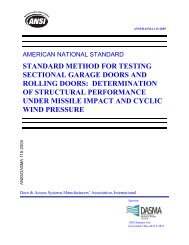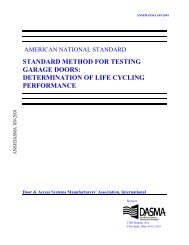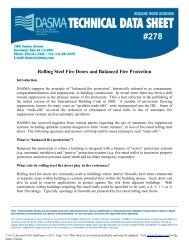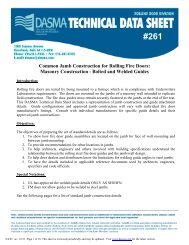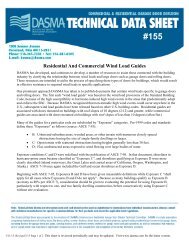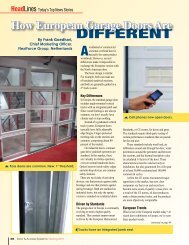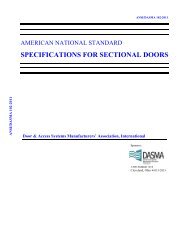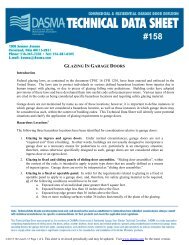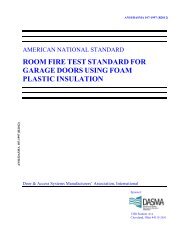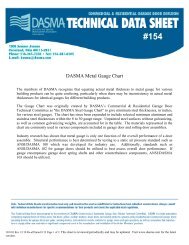Wind Load Testing - Garage Doors - DASMA Door and Access ...
Wind Load Testing - Garage Doors - DASMA Door and Access ...
Wind Load Testing - Garage Doors - DASMA Door and Access ...
Create successful ePaper yourself
Turn your PDF publications into a flip-book with our unique Google optimized e-Paper software.
<strong>DASMA</strong> 207-2008<br />
<strong>DASMA</strong> STANDARD<br />
STANDARD FOR<br />
ROLLING SHEET DOORS<br />
<strong>Door</strong> & <strong>Access</strong> Systems Manufacturers’ Association, International<br />
Sponsor:<br />
1300 Sumner Ave<br />
Clevel<strong>and</strong>, Ohio 44115-2851
<strong>DASMA</strong> 207-2008<br />
<strong>DASMA</strong> STANDARD<br />
St<strong>and</strong>ard for<br />
Rolling Sheet <strong><strong>Door</strong>s</strong><br />
Sponsor<br />
<strong>Door</strong> & <strong>Access</strong> Systems Manufacturers’ Association, International<br />
i
American<br />
National<br />
St<strong>and</strong>ard<br />
American National St<strong>and</strong>ard implies a consensus of those<br />
substantially concerned with its scope <strong>and</strong> provisions. An<br />
American National St<strong>and</strong>ard is intended as a guide to aid<br />
the manufacturer, the consumer, <strong>and</strong> the general public.<br />
The existence of an American National St<strong>and</strong>ard does not<br />
in any respect preclude anyone, whether he has approved<br />
the st<strong>and</strong>ard or not, from manufacturing, marketing,<br />
purchasing or using products, processes, or procedures not<br />
conforming to the st<strong>and</strong>ard. American National St<strong>and</strong>ards<br />
are subject to periodic review <strong>and</strong> users are cautioned to<br />
obtain the latest editions.<br />
CAUTION NOTICE:<br />
This American National St<strong>and</strong>ard may be revised or<br />
withdrawn at any time. The procedures of the American<br />
National St<strong>and</strong>ards Institute require that action be taken to<br />
reaffirm, revise, or withdraw this st<strong>and</strong>ard no later than five<br />
years from the date of publication. Purchasers of American<br />
National St<strong>and</strong>ards may receive current information on all<br />
st<strong>and</strong>ards by calling or writing the American National<br />
St<strong>and</strong>ards Institute.<br />
Sponsored <strong>and</strong> published by:<br />
DOOR & ACCESS SYSTEMS MANUFACTURERS’<br />
ASSOCIATION, INTERNATIONAL<br />
1300 Sumner Avenue<br />
Clevel<strong>and</strong>, OH 44115-2851<br />
Phn: 216/241-7333<br />
Fax: 216/241-0105<br />
E-Mail: dasma@dasma.com<br />
URL: www.dasma.com<br />
Copyright © 2008 by <strong>Door</strong> & <strong>Access</strong> Systems Manufacturers’<br />
Association, International<br />
All Rights Reserved<br />
No part of this publication may be reproduced in any form, in an electronic retrieval<br />
system or otherwise, without the prior written permission of the publisher.<br />
Suggestions for improvement of this st<strong>and</strong>ard will be welcome.<br />
They should be sent to the <strong>Door</strong> & <strong>Access</strong> Systems Manufacturers’ Association,<br />
International.<br />
Printed in the United States of America<br />
ii
CONTENTS<br />
PAGE<br />
Foreword ............................................................................................................................. iv<br />
1. Scope ............................................................................................................................ 1<br />
2. Definitions .................................................................................................................... 1-2<br />
3. General ......................................................................................................................... 2<br />
4. Material Thickness ....................................................................................................... 2<br />
5. Guide Assemblies ......................................................................................................... 2<br />
6. Curtains ........................................................................................................................ 2<br />
7. Bottom Bars .................................................................................................................. 3<br />
8. Locking Devices ........................................................................................................... 3<br />
9. Brackets ........................................................................................................................ 3<br />
10. Hoods <strong>and</strong> Hood Baffles .............................................................................................. 3<br />
11. Axle Assemblies ........................................................................................................... 3<br />
12. Tensioning Device ......................................................................................................... 3<br />
13. Operation ...................................................................................................................... 3-4<br />
14. Installation <strong>and</strong> General Operation .............................................................................. 4<br />
15. Maintenance ................................................................................................................. 4<br />
16. Labels ........................................................................................................................... 4<br />
Referenced St<strong>and</strong>ards ................................................................................................... 5<br />
Appendix A: Informational Statements ........................................................................ 6<br />
iii
Foreword (This foreword is included for information only <strong>and</strong> is not part of <strong>DASMA</strong> 207-2008, St<strong>and</strong>ard for<br />
Rolling Sheet <strong><strong>Door</strong>s</strong>.)<br />
This st<strong>and</strong>ard was developed by the Technical Committee of the <strong>DASMA</strong> Rolling <strong>Door</strong> Division.<br />
It incorporates years of experience in designing <strong>and</strong> testing non-fire-rated rolling doors.<br />
The <strong>DASMA</strong> Rolling <strong>Door</strong> Division approved the st<strong>and</strong>ard as a <strong>DASMA</strong> st<strong>and</strong>ard on January 28,<br />
2008.<br />
<strong>DASMA</strong> recognizes the need to periodically review <strong>and</strong> update this st<strong>and</strong>ard. Suggestions for<br />
improvement should be forwarded to the <strong>Door</strong> & <strong>Access</strong> Systems Manufacturers’ Association,<br />
International, 1300 Sumner Avenue, Clevel<strong>and</strong>, Ohio, 44115-2851.<br />
iv
<strong>DASMA</strong> 207-2008<br />
<strong>DASMA</strong> STANDARD<br />
St<strong>and</strong>ard for Rolling Sheet <strong><strong>Door</strong>s</strong><br />
1.0 Scope<br />
1.1 This st<strong>and</strong>ard defines minimum<br />
design <strong>and</strong> performance specifications for<br />
non-fire rated rolling sheet doors.<br />
1.2 This st<strong>and</strong>ard for rolling sheet door<br />
assemblies shall be intended to cover<br />
commercial <strong>and</strong> industrial type warehouses,<br />
factories, self storage <strong>and</strong> other facilities.<br />
1.3 This st<strong>and</strong>ard is not intended to<br />
cover doors such as rigid, folding or multileaf<br />
sectional type doors, rolling fire doors,<br />
rolling doors, perforated slat construction,<br />
or special applications. Rolling sheet doors<br />
intended for frequent use should be<br />
designed for high cycle operation. Refer to<br />
Section 11.1.2.<br />
1.4 Without limitation, <strong>DASMA</strong> does<br />
not represent or imply that this st<strong>and</strong>ard<br />
relates to any component or system other<br />
than the rolling sheet doors expressly<br />
identified <strong>and</strong> described herein.<br />
1.5 See informational statements in<br />
Appendix A on important design <strong>and</strong><br />
operation information.<br />
2.0 Definitions.<br />
2.1 Axle Assembly: A horizontal<br />
member at the head of the opening that<br />
supports the curtain <strong>and</strong> contains the<br />
counterbalance spring(s).<br />
2.2 Bottom Bar: A reinforcing<br />
member at the lower edge of the door<br />
curtain assembly. It may be provided with<br />
an astragal or sensing edge.<br />
2.3 Brackets: Support members above<br />
the top of the wall opening to which the<br />
1<br />
axle assembly is attached.<br />
2.4 Counterbalance Assembly: An<br />
assembly consisting of torsion springs,<br />
spring anchors, <strong>and</strong> a shaft, which is<br />
positioned on the axle assembly.<br />
2.5 Counter Shutter: A door used to<br />
close an opening, which closes on a<br />
counter-type sill.<br />
2.6 Curtain: An assembly of curtain<br />
panels seamed together.<br />
2.7 Cycle: An action on the door from<br />
the fully closed position, to the fully open<br />
position, <strong>and</strong> returned to the fully closed<br />
position.<br />
2.8 Guide: Vertical assembly in which<br />
the curtain travels <strong>and</strong> that is fastened to the<br />
jamb, retaining the edges of the door curtain<br />
<strong>and</strong> closing the space between the curtain<br />
edges <strong>and</strong> the jamb.<br />
2.9 Hood: A sheet metal housing that<br />
mounts horizontally over the coiled curtain<br />
<strong>and</strong> brackets, serving as a cover for the<br />
coiled curtain <strong>and</strong> closing the door space<br />
between the door coil <strong>and</strong> the header.<br />
2.10 Hood Baffle: A flap of material<br />
with one end secured to the interior of the<br />
hood <strong>and</strong> the other end resting on the<br />
curtain, <strong>and</strong> designed to retard air<br />
infiltration over the top of the curtain <strong>and</strong><br />
through the hood.<br />
2.11 Interlock, External: An electrical<br />
switch to prevent motor operation if locking<br />
device is engaged.<br />
2.12 Rolling Sheet <strong>Door</strong>: A vertically<br />
operating, coiling door typically used in
commercial, industrial or self-storage<br />
applications, with a curtain consisting of<br />
formed metal sheets seamed together.<br />
2.13 Spring Anchor: A component in a<br />
counterbalance assembly, that holds a<br />
spring in place while it is under tension.<br />
2.14 Stops: Bars mounted at top of<br />
guides to prevent bottom bar from traveling<br />
out of the guides when the curtain is fully<br />
raised.<br />
2.15 Tensioning Device: A component<br />
attached to the counterbalance shaft, which<br />
controls the spring tension as it is locked to<br />
the bracket.<br />
2.16 Torsion Spring: A helical wound<br />
spring in a counterbalance assembly, used<br />
to counterbalance the curtain.<br />
2.17 <strong>Wind</strong> Bar: Channel or bar welded<br />
inside guide groove, which engage<br />
windlocks under wind load.<br />
2.18 <strong>Wind</strong>lock: A component attached at<br />
predetermined intervals to sheet ends to<br />
prevent curtain from leaving the guides under<br />
wind load, <strong>and</strong> which is used in conjunction<br />
with wind bars inside the guides.<br />
3.0 General<br />
3.1 <strong>Wind</strong> <strong>Load</strong>s<br />
3.1.1 <strong>Door</strong> system shall be designed<br />
to withst<strong>and</strong> a minimum wind<br />
load as required by the authority<br />
having jurisdiction over the<br />
geographic location where the<br />
door is to be installed. When<br />
required by the authority having<br />
jurisdiction, structural tests shall<br />
be in accordance with<br />
ANSI/<strong>DASMA</strong> 108 or other<br />
accepted means required by the<br />
authority having jurisdiction.<br />
3.1.2 Where resistance to windborne<br />
debris is required by the<br />
authority having jurisdiction<br />
over the geographic location<br />
where the door is to be installed,<br />
a door system shall meet the<br />
requirements of ANSI/<strong>DASMA</strong><br />
115 or other accepted means as<br />
required by the authority having<br />
jurisdiction.<br />
4.0 Material Thickness<br />
4.1 Metal gauge shall comply with<br />
information shown in <strong>DASMA</strong> TDS-154.<br />
5.0 Guide Assemblies<br />
5.1 Guide assemblies shall contain the<br />
curtain edges throughout the door operation<br />
<strong>and</strong> under the required wind load.<br />
5.2 Guide assembly design shall allow<br />
for installation variances in the distance<br />
between left <strong>and</strong> right guides of ±1/8 inch (3<br />
mm) within the specified value provided by<br />
the door manufacturer.<br />
5.3 Guide assemblies shall be<br />
constructed to support the wind loads<br />
transmitted by the curtain.<br />
5.4 Guide assemblies shall include<br />
stops on the guides to ensure the rolling<br />
sheet door opens to a designated position.<br />
6.0 Curtains<br />
6.1 Curtain shall coil around the axle<br />
assembly without binding or separation.<br />
6.2 Curtains shall be designed to resist<br />
lateral motion.<br />
6.3 Where windlocks are required,<br />
windlock construction, material <strong>and</strong><br />
attachment to curtain shall be adequate to<br />
resist wind load.<br />
2
6.4 When subjected to the provisions<br />
of Section 3.1, curtain performance shall be<br />
such that the door shall remain operable<br />
after removal of the wind load.<br />
6.5 Steel curtain shall conform to<br />
ASTM A653/A653M, G40 minimum zinc<br />
coating, or equivalent, with grade chosen by<br />
manufacturer to meet performance<br />
requirements set forth herein. Curtain may<br />
be painted.<br />
6.6 For other materials <strong>and</strong> finishes,<br />
contact manufacturer for availability.<br />
6.7 Insulating material shall meet<br />
requirements established by the authority<br />
having jurisdiction for flame spread <strong>and</strong><br />
smoke development.<br />
7.0 Bottom Bars<br />
A bottom bar may incorporate an astragal or<br />
sensing edge.<br />
8.0 Locking Devices<br />
8.1 A curtain or a bottom bar may be<br />
designed to incorporate locks that engage at<br />
one or both sides.<br />
8.2 If a locking mechanism is<br />
incorporated on a motor operated door, one<br />
of the following shall be installed:<br />
8.2.1 Guide mounted external<br />
interlock.<br />
8.2.2 An operator with the ability to<br />
sense either torque or starting<br />
current to the motor.<br />
9.0 Brackets<br />
9.1 Brackets shall be designed to<br />
support the curtain, the bottom bar <strong>and</strong> the<br />
axle assembly.<br />
10.0 Hoods <strong>and</strong> Hood Baffles<br />
10.1 Hoods, when provided, shall be<br />
constructed with gauge thickness in<br />
accordance with <strong>DASMA</strong> TDS-154.<br />
10.2 A hood, or hood fasteners, shall not<br />
be in contact with the curtain during any<br />
position of the door.<br />
10.3 A hood baffle (when required) shall<br />
maintain full-width contact with the curtain<br />
when the door is closed.<br />
10.4 A hood baffle shall not hinder<br />
operation of the door.<br />
11.0 Axle Assemblies<br />
11.1 Torsion Springs<br />
11.1.1 Helical wound spring wire shall<br />
comply with ASTM-A229 or equivalent.<br />
11.1.2 Springs shall be designed for a<br />
minimum of 10,000 cycles of operation.<br />
Higher cycle life may be specified.<br />
11.2 Spring Anchors<br />
11.2.1 Spring anchors shall be designed<br />
to withst<strong>and</strong> the radial <strong>and</strong> lateral forces<br />
exerted by the torsion spring to properly<br />
retain the spring when fully wound or<br />
unwound <strong>and</strong> allow the application of<br />
torque.<br />
12.0 Tensioning Device<br />
Tensioning device <strong>and</strong> locking mechanism<br />
shall be designed with sufficient strength to<br />
withst<strong>and</strong> the maximum torque from torsion<br />
springs, <strong>and</strong>/or winding devices.<br />
12.1 Tensioning device <strong>and</strong> locking<br />
mechanism shall be designed with sufficient<br />
strength to withst<strong>and</strong> the maximum torque<br />
from torsion springs, <strong>and</strong>/or winding<br />
devices.<br />
13.0 Operation<br />
3
13.1 A door normally operated by chain<br />
hoist shall not require more than 35 pounds<br />
(156 N) of force to operate the door.<br />
13.2 A door normally operated by using<br />
a crank shall not require more than 25<br />
pounds (111 N) of force to operate the door.<br />
13.3 A door normally operated by<br />
manually pushing up the door shall not<br />
require more than 30 pounds (134 N) of<br />
force to operate the door. Recommended<br />
maximum door height is 10 feet.<br />
13.3.1 A door required to be ADA<br />
compliant shall not require more<br />
than 5 pounds (22 N) of force to<br />
operate the door.<br />
14.0 Installation <strong>and</strong> General Operation<br />
14.1 The door manufacturer shall<br />
furnish st<strong>and</strong>ard details <strong>and</strong> instructions for<br />
proper installation <strong>and</strong> general operation.<br />
Such instructions shall include warnings<br />
relative to the installation <strong>and</strong> general<br />
operation of the door.<br />
15.0 Maintenance<br />
15.1 The door manufacturer shall<br />
furnish a list of components requiring<br />
regular maintenance, with instructions on<br />
<strong>and</strong> frequencies for such maintenance.<br />
16.0 Labels<br />
16.1 Each door shall be labeled to<br />
identify the name <strong>and</strong> address of the door<br />
manufacturer.<br />
16.2 <strong>DASMA</strong> labels RDD-201 <strong>and</strong><br />
RDD-204 shall be placed on the door as<br />
described in TDS-267.<br />
16.2.1 Labels in accordance with the<br />
applicable provisions of ANSI-Z535.1,<br />
ANSI-Z535.3, ANSI-Z535.4, shall be<br />
placed on the door.<br />
4
Referenced St<strong>and</strong>ards<br />
ANSI-Z535.1, Safety Color Code<br />
ANSI-Z535.3, Criteria for Safety Symbols<br />
ANSI-Z535.4, Product Safety Signs <strong>and</strong> Labels<br />
ANSI/<strong>DASMA</strong> 108, St<strong>and</strong>ard Method for <strong>Testing</strong> <strong>Garage</strong> <strong><strong>Door</strong>s</strong> <strong>and</strong> Rolling <strong><strong>Door</strong>s</strong>:<br />
Determination of Structural Performance Under Uniform Static Air Pressure Difference<br />
ANSI/<strong>DASMA</strong> 115, St<strong>and</strong>ard Method for <strong>Testing</strong> <strong>Garage</strong> <strong><strong>Door</strong>s</strong> <strong>and</strong> Rolling <strong><strong>Door</strong>s</strong>:<br />
Determination of Structural Performance Under Missile Impact <strong>and</strong> Cyclic <strong>Wind</strong> Pressure<br />
ASTM-B221, St<strong>and</strong>ard Specification for Aluminum <strong>and</strong> Aluminum-Alloy Bar, Rod, <strong>and</strong> Wire<br />
ASTM-A229, St<strong>and</strong>ard Specification for Steel Wire, Oil-Tempered for Mechanical Springs<br />
ASTM-A240, St<strong>and</strong>ard Specification for Heating-Resisting Chromium <strong>and</strong> Chromium-Nickel<br />
Stainless Steel Plate, Sheet, <strong>and</strong> Strip for Pressure Vessels <strong>and</strong> for General ApplicationsASTM-<br />
B209, St<strong>and</strong>ard Specification for Aluminum <strong>and</strong> Aluminum-Alloy Sheet <strong>and</strong> Plate<br />
ASTM A653/A653M, St<strong>and</strong>ard Specification for Steel Sheet, Zinc-Coated (Galvanized) or<br />
Zinc-Iron Alloy-Coated (Galvannealed) by the Hot-Dip Process<br />
<strong>DASMA</strong> TDS-154, Steel Gauge Chart<br />
<strong>DASMA</strong> TDS-251, Architects <strong>and</strong> Designers Should Underst<strong>and</strong> <strong>Load</strong>s Exerted by Overhead<br />
Coiling <strong><strong>Door</strong>s</strong><br />
<strong>DASMA</strong> TDS-267, Rolling <strong>Door</strong> Labels<br />
<strong>DASMA</strong> TDS-272, Rolling <strong>Door</strong> Counterbalancing<br />
<strong>DASMA</strong> TDS-277, Metal Coiling Slat <strong>Door</strong> Terminology<br />
5
Appendix A: Informational Statements<br />
A.1. Rolling sheet doors with windlocks cannot be operated when wind load engages the<br />
windlocks, due to the sliding friction of the curtain within the guides. Contact the manufacturer<br />
for special requirements.<br />
A.2. <strong>Load</strong>s are imposed onto the building structure from two sources: <strong>Wind</strong> load <strong>and</strong> door<br />
weight. <strong>Wind</strong> loading can produce substantial catenary forces in rolling sheet doors as a result<br />
of the locking action of the curtain edges within the guides. The jambs must be designed to<br />
withst<strong>and</strong> these loads. These loads are in addition to those created by the direct wind pressure<br />
<strong>and</strong> weight of the door assembly. The magnitude <strong>and</strong> direction of these loads should be obtained<br />
from the manufacturer. <strong>DASMA</strong> Technical Data Sheet TDS-251 may be used to state these<br />
loads.<br />
A.3. After being subjected to wind loading, rolling sheet doors may retain some curvature in the<br />
curtain, particularly on narrow doors.<br />
A.4. Calculations for overall performance <strong>and</strong> pass/fail prediction of the door system are well<br />
established. Detailed stresses in the curtain sheets under wind loads cannot be calculated<br />
accurately since the large-deflection of these parts invalidates the assumptions used to derive<br />
common engineering formulae.<br />
6
<strong>DASMA</strong> – The <strong>Door</strong> & <strong>Access</strong> Systems Manufacturers Association, International –<br />
is North America’s leading trade association of manufacturers of garage doors, rolling<br />
doors, garage door operators, vehicular gate operators, <strong>and</strong> access control products.<br />
With Association headquarters based in Clevel<strong>and</strong>, Ohio, our 90 member companies<br />
manufacture products sold in virtually every county in America, in every U.S. state,<br />
every Canadian province, <strong>and</strong> in more than 50 countries worldwide. <strong>DASMA</strong> members’<br />
products represent more than 95% of the U.S. market for our industry.<br />
For more information about the <strong>Door</strong> & <strong>Access</strong> Systems Manufacturers Association,<br />
International, contact:<br />
<strong>DASMA</strong><br />
1300 Sumner Avenue<br />
Clevel<strong>and</strong>, OH 44115-2851<br />
Phn: 216/241-7333<br />
Fax: 216/241-0105<br />
E-Mail: dasma@dasma.com<br />
URL: www.dasma.com<br />
7



